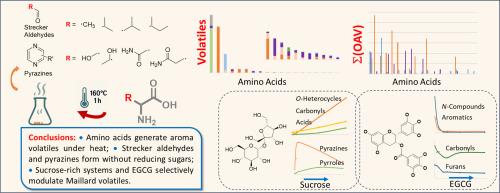Formation of aroma active volatiles from thermal degradation of 18 amino acids with or without sugars in low-moisture systems and the modulation by sucrose and epigallocatechin gallate
IF 8
1区 农林科学
Q1 FOOD SCIENCE & TECHNOLOGY
引用次数: 0
Abstract
This study investigates the thermal degradation of 18 proteinogenic amino acids at 160 °C for 1 h under low-moisture conditions, focusing on the formation of volatile compounds. The structure of amino acid side chains strongly influenced volatile profiles and reaction pathways. Serine and phenylalanine produced the highest levels of volatiles; notably, even in the absence of reducing sugars, amino acids with aliphatic hydroxyl groups (serine and threonine) and with amide groups (glutamine and asparagine) in their side chains generated pyrazines. Significant Strecker aldehyde formation was observed for branched chain amino acids (alanine, isoleucine, and leucine) and valine without sugars. When a sucrose-rich sugar mix, simulating the composition of tea leaves introduced, volatile profiles shifted toward furans, aldehydes, and acids, and modulating pyrazine formation. The presence of epigallocatechin gallate (EGCG) suppressed nitrogen-containing volatiles and dicarbonyls while preserving furans and aldehydes. Aroma impact, assessed by the sum of odor activity values (ΣOAV), suggested potentially significant sensory contributions. While the findings provide general insights into amino acids-derived volatiles relevant to thermal processing, the sugars and EGCG model matrix was based on tea and is primarily applicable to the roasting of baked teas.

18种氨基酸在低湿度系统中有糖或无糖热降解形成香气活性挥发物及蔗糖和表没食子儿茶素没食子酸酯的调节
本研究考察了18种蛋白源性氨基酸在低水分条件下160°C 1 h的热降解,重点研究了挥发性化合物的形成。氨基酸侧链的结构强烈影响挥发谱和反应途径。丝氨酸和苯丙氨酸产生的挥发物含量最高;值得注意的是,即使在没有还原糖的情况下,具有脂肪羟基(丝氨酸和苏氨酸)和酰胺基团(谷氨酰胺和天冬酰胺)的氨基酸侧链也会生成吡嗪。无糖支链氨基酸(丙氨酸、异亮氨酸和亮氨酸)和缬氨酸形成显著的streker醛。当引入一种富含蔗糖的糖混合物,模拟茶叶的组成时,挥发性特征转向呋喃、醛和酸,并调节吡嗪的形成。表没食子儿茶素没食子酸酯(EGCG)的存在抑制了含氮挥发物和二羰基,同时保留了呋喃和醛。通过气味活动值的总和(ΣOAV)评估的香气影响表明,潜在的显著感官贡献。虽然这些发现提供了与热加工相关的氨基酸衍生挥发物的一般见解,但糖和EGCG模型矩阵是基于茶的,主要适用于烘焙茶的烘烤。
本文章由计算机程序翻译,如有差异,请以英文原文为准。
求助全文
约1分钟内获得全文
求助全文
来源期刊

Food Research International
工程技术-食品科技
CiteScore
12.50
自引率
7.40%
发文量
1183
审稿时长
79 days
期刊介绍:
Food Research International serves as a rapid dissemination platform for significant and impactful research in food science, technology, engineering, and nutrition. The journal focuses on publishing novel, high-quality, and high-impact review papers, original research papers, and letters to the editors across various disciplines in the science and technology of food. Additionally, it follows a policy of publishing special issues on topical and emergent subjects in food research or related areas. Selected, peer-reviewed papers from scientific meetings, workshops, and conferences on the science, technology, and engineering of foods are also featured in special issues.
 求助内容:
求助内容: 应助结果提醒方式:
应助结果提醒方式:


